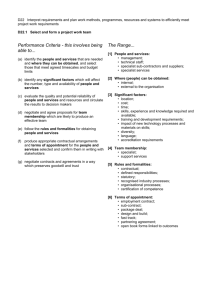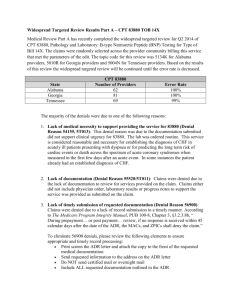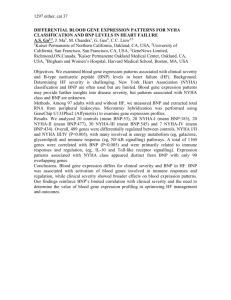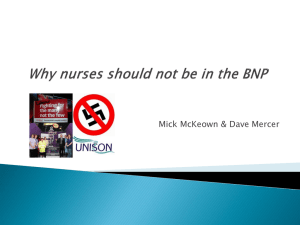Heart starter testing
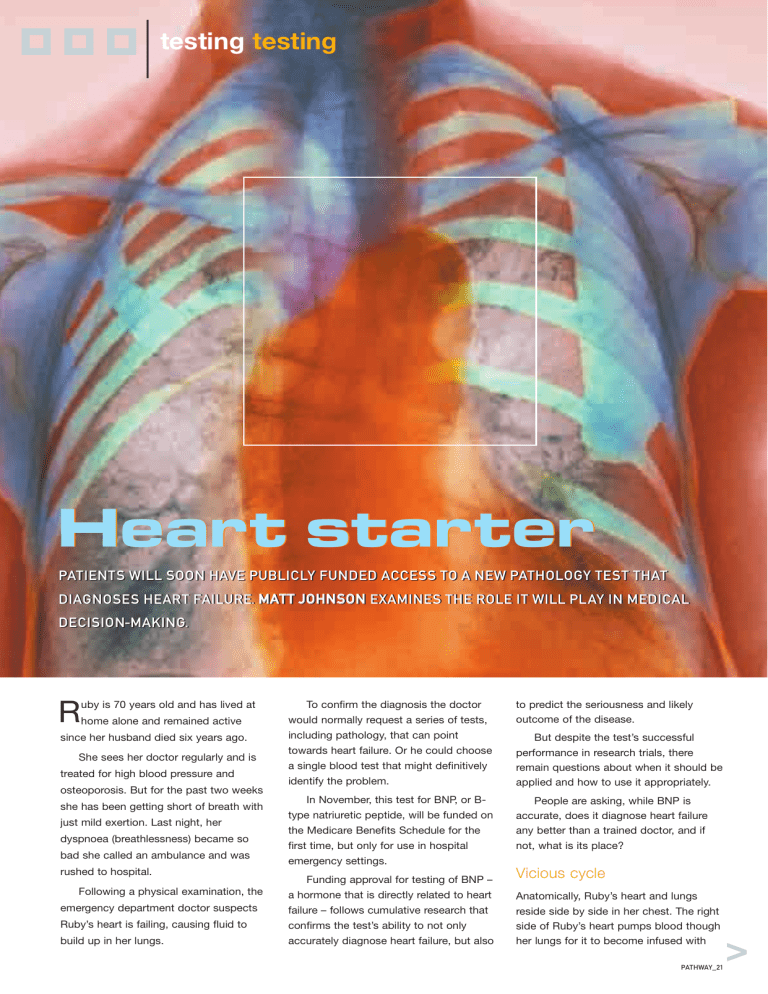
testing testing
DIAGNOSES HEART FAILURE. M AT T J OH NS ON
R uby is 70 years old and has lived at home alone and remained active since her husband died six years ago.
She sees her doctor regularly and is treated for high blood pressure and osteoporosis. But for the past two weeks she has been getting short of breath with just mild exertion. Last night, her dyspnoea (breathlessness) became so bad she called an ambulance and was rushed to hospital.
Following a physical examination, the emergency department doctor suspects
Ruby’s heart is failing, causing fluid to build up in her lungs.
To confirm the diagnosis the doctor would normally request a series of tests, including pathology, that can point towards heart failure. Or he could choose a single blood test that might definitively identify the problem.
In November, this test for BNP, or Btype natriuretic peptide, will be funded on the Medicare Benefits Schedule for the first time, but only for use in hospital emergency settings.
Funding approval for testing of BNP – a hormone that is directly related to heart failure – follows cumulative research that confirms the test’s ability to not only accurately diagnose heart failure, but also to predict the seriousness and likely outcome of the disease.
But despite the test’s successful performance in research trials, there remain questions about when it should be applied and how to use it appropriately.
People are asking, while BNP is accurate, does it diagnose heart failure any better than a trained doctor, and if not, what is its place?
Vicious cycle
Anatomically, Ruby’s heart and lungs reside side by side in her chest. The right side of Ruby’s heart pumps blood though her lungs for it to become infused with
PATHWAY_21
>
oxygen and unload carbon dioxide. That diffusion of gases occurs across a membrane made up of one thin capillary cell and one thin lung cell and is only 0.5
to 1.0 µm thick. Any thicker, and the diffusion could not occur before the blood leaves the lungs.
The left side of Ruby’s heart then has to pump that oxygenated blood through her much longer systemic circuit, delivering the oxygen to her cells. When the left ventricle, through injury, age or disease, cannot pump against the resistance, blood backs up into the pulmonary circuit. If this occurs the fluid in the pulmonary circuit can start to force its way out of the capillaries, thickening the barrier between the blood and the lungs and increasing the distance oxygen has to travel to get into the blood.
Ironically, the body’s response to this lack of oxygen is to get the heart to pump faster and further increase Ruby’s blood pressure in an attempt to circulate more blood. This places more strain on her left ventricle, and too often speeds the rate of
BNP levels:
CA US
what they mean
S O F IIN EA SE D B NP EV EL S
• CARDIAC FAILURE
• HEART ATTACK (MYOCARDIAL INFARCTION)
• PULMONARY EMBOLISM
• LIVER CIRRHOSIS
• OBSTRUCTIVE PULMONARY DISEASE
• RENAL FAILURE
• INCREASED AGE
HE N A CT OR GH T C EC K B NP EV EL S
• TO ASSIST WITH THE DIAGNOSIS OF HEART FAILURE
PARTICULARLY WHERE THERE ARE CONFOUNDING
FACTORS
• TO MONITOR RESPONSE TO THERAPY FOR CARDIAC
FAILURE
• TO DETERMINE WHEN A PATIENT CAN BE DISCHARGED failure. This vicious cycle is why heart failure is associated with such a poor prognosis.
It’s estimated that 5–10% of
Australians older than 65 have a degree of heart failure.
Unlike other cardiovascular conditions, heart failure is actually increasing in incidence and is now the leading cause of hospitalisation for patients over 65.
The increase may partly be due to better treatment of heart attacks
(myocardial infarctions), allowing patients who would previously have died to survive, but with a damaged heart.
The self-propagating nature of the condition within an ageing population also means the already substantial burden it imposes on the healthcare system will undoubtedly increase.
This increase in the rate of heart failure has occurred despite two decades of diagnostic and therapeutic advances that have decreased the morbidity and mortality of chronic heart failure once it has been diagnosed.
So there is a suspicion that the vast majority of patients with early – or
‘symptomless’ – left ventricular dysfunction remain undiagnosed until the disease process is firmly established.
Part of the problem with developing an early diagnosis is that most of the tests for heart failure – electrocardiograms
(ECGs), chest x-rays and blood tests for electrolytes, albumin, blood urea nitrogen, creatinine, glucose, liver enzymes and thyroid-stimulating hormone – all look for changes caused by the failure, not the failure itself.
Using sound waves, echocardiograms allow doctors to watch the heart beat and assess ventricular function, but they’re rarely available in local general practice and smaller emergency departments, where most ‘early’ patients present.
And even in larger emergency departments, where they are commonly
22_PATHWAY
“BNP seems to be a very powerful predictor of mortality and this could be useful in determining which patients on a transplant list are at a higher risk and need a more urgent transplant”
– Associate Professor Hans Schneider used, studies suggest they correctly identify only 25–30% of failure cases with left ventricular dysfunction.
All these areas of uncertainty have left
GPs unsure of when to initiate further invasive and expensive tests, and even within emergency departments where there are more diagnostic facilities available, doctors often remain tentative when diagnosing failure.
A recent survey of one North
American hospital ( Circulation 2002; 106:
416–22) found casualty doctors admitted uncertainty in diagnosing cardiac failure in
40% of cases, especially where they had to differentiate between dyspnoea caused by heart failure and dyspnoea due to other causes. It’s understandable, then, that the medical community was excited by the discovery of a hormone secreted by the heart when it’s under stress that could be used to diagnose heart failure.
Symptoms of heart failure
• Difficulty breathing or shortness of breath, when exercising or at rest
BNP hits the spotlight
“We’ve known about BNP for a while but it was not initially considered as a test for the causes of dyspnoea,” explains Dr
Samuel Vasikaran, Chemical Pathologist at Royal Perth Hospital.
• Swollen legs, ankles or feet from a build-up of fluid (oedema)
• Weight gain (from increased fluid retention)
“For a long time BNP was principally studied as a hormone that affected salt and water levels in the body, and it’s taken a long time to clarify its diagnostic potential when it comes to heart failure.”
• Decreased ability to exercise
• Tiredness after normal activities
BNP is a neurohormone produced principally by the ventricles of the heart and released when the heart muscles become overstretched.
Released into the blood, BNP reduces the cardiac load by dilating blood vessels and reducing their blood volume by increasing the amount of urine they excrete. It also opposes the vasoconstriction and hypertension caused >
• Cough with activity or at rest
• Once a diagnosis has been made, these symptoms may be used to help classify the disease and monitor therapy
PATHWAY_23
“There’s potentially a link between BNP and death from a myocardial infarction, and it’s being investigated if it can be used to identify these patients”
– Dr Samuel Vasikaran by the body’s response to the shortness of breath.
There are now numerous studies showing a correlation between BNP levels and heart failure. Compared with echocardiography, one study found up to
97% of incorrect clinical diagnoses of dyspnoea in an emergency department setting were correctly diagnosed based solely upon BNP measurement.
Interestingly, the BNP gene contains a destabilising sequence that suggests the release and breakdown of BNP is relatively rapid, with the hormone synthesised in bursts in response to ventricular overload.
“The initial studies used in the general practice setting used BNP levels to help decide if a patient should be referred to a cardiologist or for an echocardiogram,” Dr
Vasikaran explains.
“In this setting, BNP was found to be very useful as a screening process as it had good sensitivity, and a negative result ruled out heart failure and meant the patient didn’t have to undergo unnecessary tests.”
The studies referred to by Dr
Vasikaran include a 2002 New Zealand study, where 305 patients, all of whom had shortness of breath or ankle swelling, were randomised into two groups after an initial cardiac assessment ( The Lancet
2002; 360:545-546).
Half the patients were reviewed by
GPs who were given the BNP results, with the other half forming a control group reviewed by GPs using customary clinical assessment without the BNP result.
The study found the GPs who had access to the BNP result improved their diagnostic accuracy by 21% compared to an 8% improvement in the control group.
Interestingly, the increase in accuracy was mainly due to GPs ruling out heart failure if the BNP result was normal.
“The initial studies stimulated a lot of interest and that prompted people to think
BNP could be useful in emergency departments to investigate if dyspnoea was failure related,” Dr Vasikaran says, adding that the promise in this setting is now being investigated in several large studies, including a well-structured trial at
The Alfred Hospital in Melbourne.
Investigations deepen
Associate Professor Hans Schneider,
Director of Pathology Services at The
Alfred, is heading one of these studies and attempting to clarify when and how
BNP should be used in the emergency department.
24_PATHWAY
OF COURSE YOU INVEST IN YOUR HEALTH…
But, is everything covered?
When it comes to maintaining your health, you know how to optimize it. But, will you be prepared when you need healthcare?
Are you prepared?
You think twice when you’re paying ‘just in case’ something happens. However, life is full of random events which can impose unfortunate outcomes. With high healthcare costs even a happy event like childbirth or a common procedure like a shoulder arthroscopy will cost more than $6,000.
What you can do
To deal with those unexpected healthcare episodes The Doctors’ Health Fund can help you choose cover to fit your healthcare and financial expectations. With the Federal government’s initiatives you can reduce your health insurance costs and taxation, even with our lowest level of hospital cover your reduction will be more than $640.
PLUS! Get your cover in place before you turn 31 and save 2% per year.
The Doctors’ Health Fund – here for you
We’re your not-for-profit private health insurance fund, offering you a choice of high quality health cover. From very economical to our ‘Top Cover’ with the greatest medical benefits in Australia, which are based on AMA List fees.
For all the information you need and to join visit www.doctorshealthfund.com.au or contact us at 1800 226 126 or info@doctorshealthfund.com.au
Testing options
His study is designed to assess how well BNP can determine left ventricular dysfunction in patients at high risk of the condition but without known cardiac dysfunction, symptoms of heart failure or previous diagnosis of either condition.
While he shares the enthusiasm for
BNP as a test, he is concerned some of the earlier studies may not have been sufficiently well designed to be entirely accurate in terms of whether it diagnoses heart failure more accurately than a doctor.
Too often, he says, the test doesn’t actually change a patient’s diagnosis.
“From what I’ve seen from the published studies, the performance of the
BNP test is about as good as an emergency department doctor,” Professor
Schneider says.
“Most studies suggest using both the doctor and the test gives better results, but we need a large randomised control study to establish when the test actually affects the decision made by the doctor.
“There is probably a clear benefit when the doctor really is unsure, but an early assessment of our results suggests that when the doctor says there’s failure, they’re right, and when they say there is no failure, they’re also right. It doesn’t say the test is bad, just that the benefits may be overstated. Those early studies had enormous publicity, especially from the point of view of triaging patients – and some, like the New Zealand study, were very well constructed, where BNP was used to not only identify patients with heart failure but also to help manage their care and their medications, and that led to less hospital admissions and readmissions.”
However, Professor Schneider warns the test could easily become overprescribed.
He is more confident of the role of
BNP testing once patients have been diagnosed with heart failure, and says it might also be useful in determining which patients require an urgent heart transplant.
“In these patients there are definitely benefits in monitoring their BNP level to
T he actual test for BNP is relatively simple and requires only 5 mL of blood, but two test procedures are currently available.
One tests for raw BNP levels, and a second looks for only a portion of the BNP molecule, called the NTproBNP test.
“In my opinion the two tests are pretty much the same,”
Professor Schneider says.
“The only real difference is that NTproBNP testing is a little more stable and isn’t affected by time or temperature, so if we are moving towards having 24-hour testing seven days a week it could be more practical.”
While both tests have good sensitivity and accuracy, interpretation of the results remains an open field.
“Renal failure, pulmonary embolism and other conditions affect BNP levels,” Dr Vasikaran says, “and it also increases with age so to determine a reference range of what are truly normal and abnormal values will take very large numbers of patients – and possibly years – before we gather the data.” assess how well we are managing their condition and to optimise their treatment regimes,” he says.
“BNP seems to be a very powerful predictor of mortality and this could be useful in determining which patients on a transplant list are at a higher risk and need a more urgent transplant.”
BNP has also been investigated by a number of other researchers trying to determine if it should be added to the current battery of tests applied to patients who complain of ischaemic chest pain.
“There’s potentially a link between
BNP and death from a myocardial infarction, and it’s being investigated if it can be used to identify these patients,”
Dr Vasikaran says.
“But it’s simply too early to tell if it will be effective.”
Research published in June in the
Journal of the American College of
Cardiology (2007; 50 (3): 215-16) with the headline “Utile or Futile” looked at this question.
The authors found a sufficient link between mortality and BNP to claim a single BNP value in these patients is sufficient to assign them with a risk level, and that BNP and other neurohormones may be the unifying link in patients who die from coronary artery disease.
So while its final use is yet to be determined, it appears BNP – a test that has been around for some time – may actually be among a new generation of cardiac tests that will not only help diagnose patients before they become ill, but improve outcomes if they manage to slip through the net.
Until then, doctors and pathologists might have to move past their conception of the heart as just a pump and start thinking of it as a gland, excreting hormones that can dramatically affect its function.
GPs NOTE: This article is available for patients at http://pathway.rcpa.edu.au
PATHWAY_25
